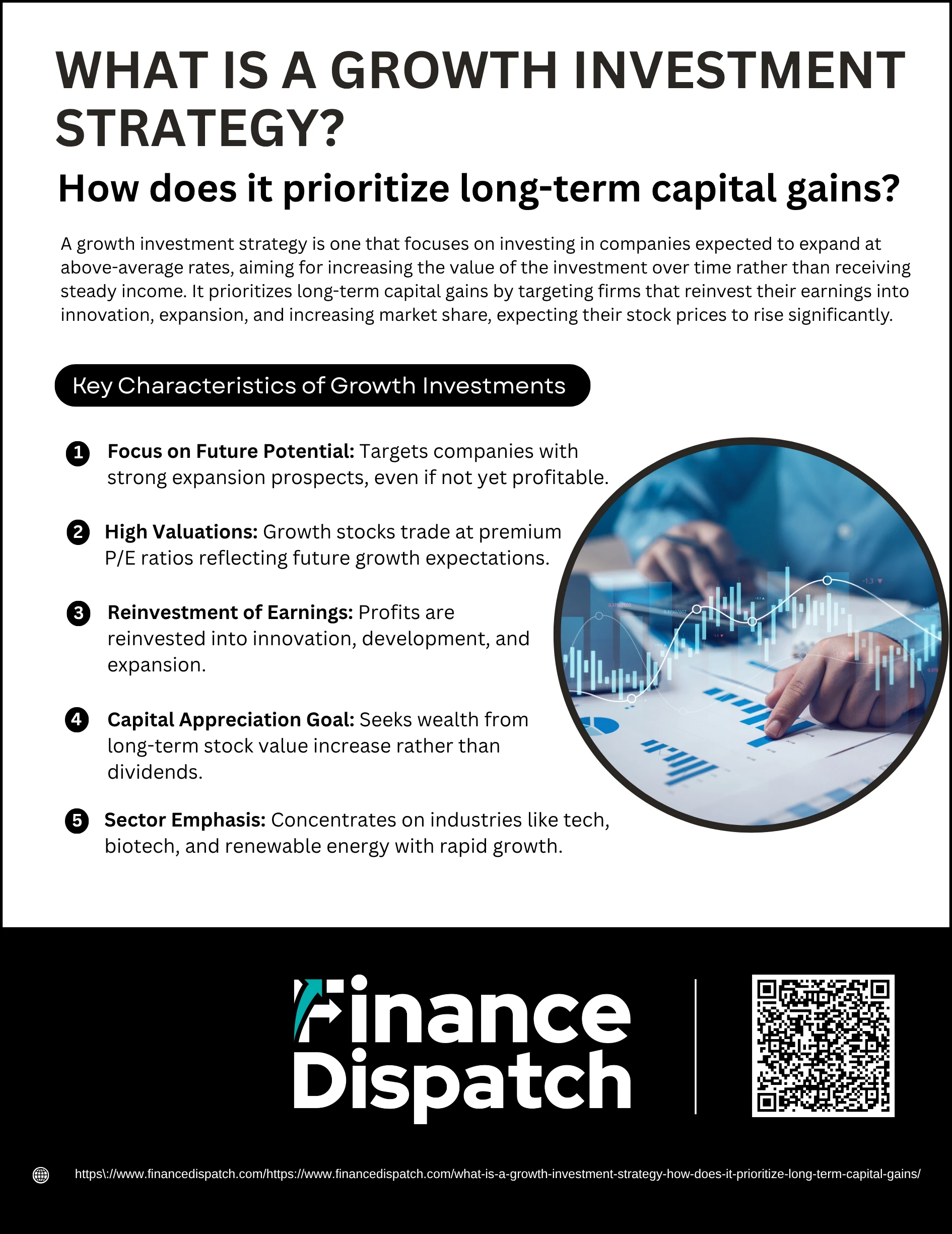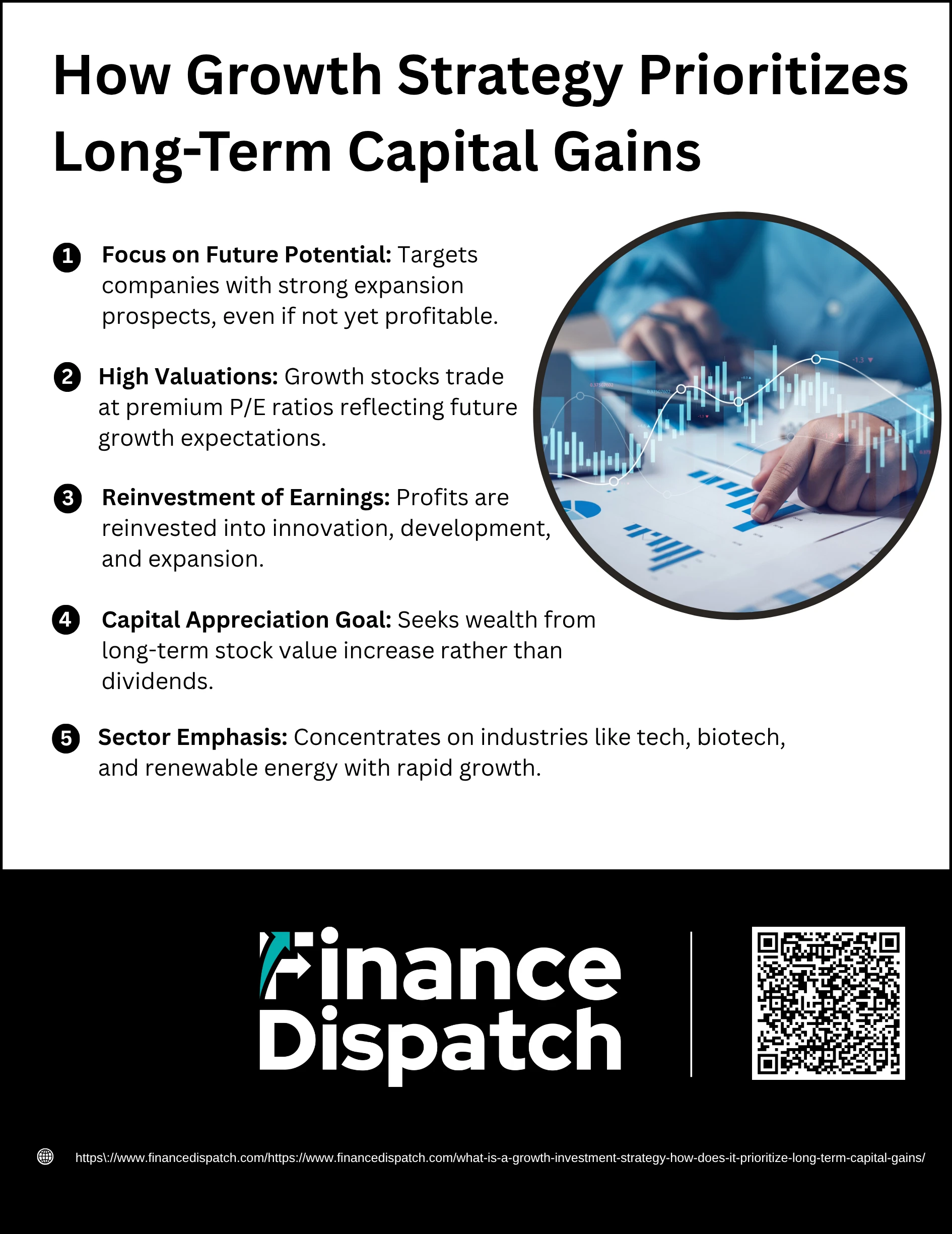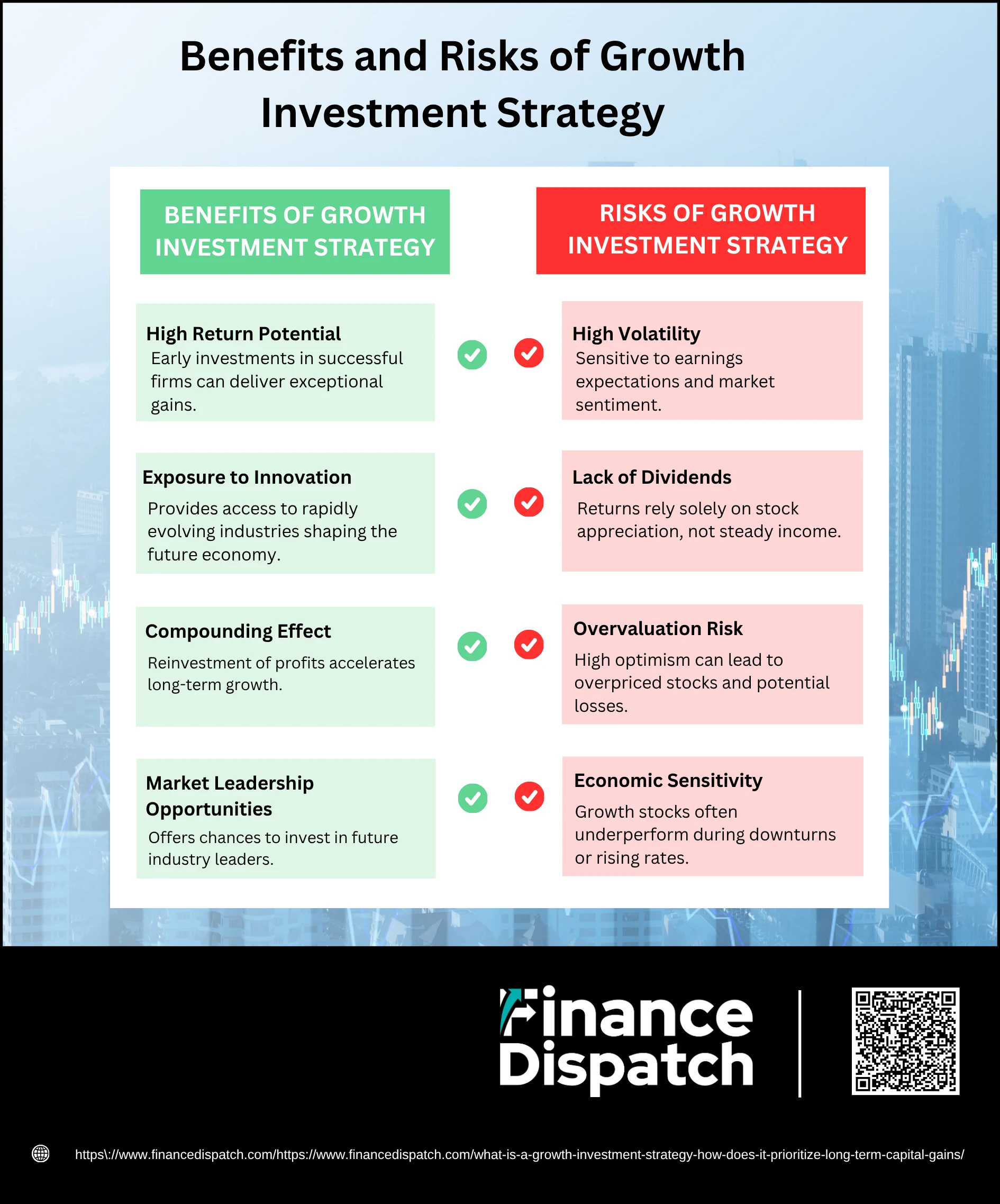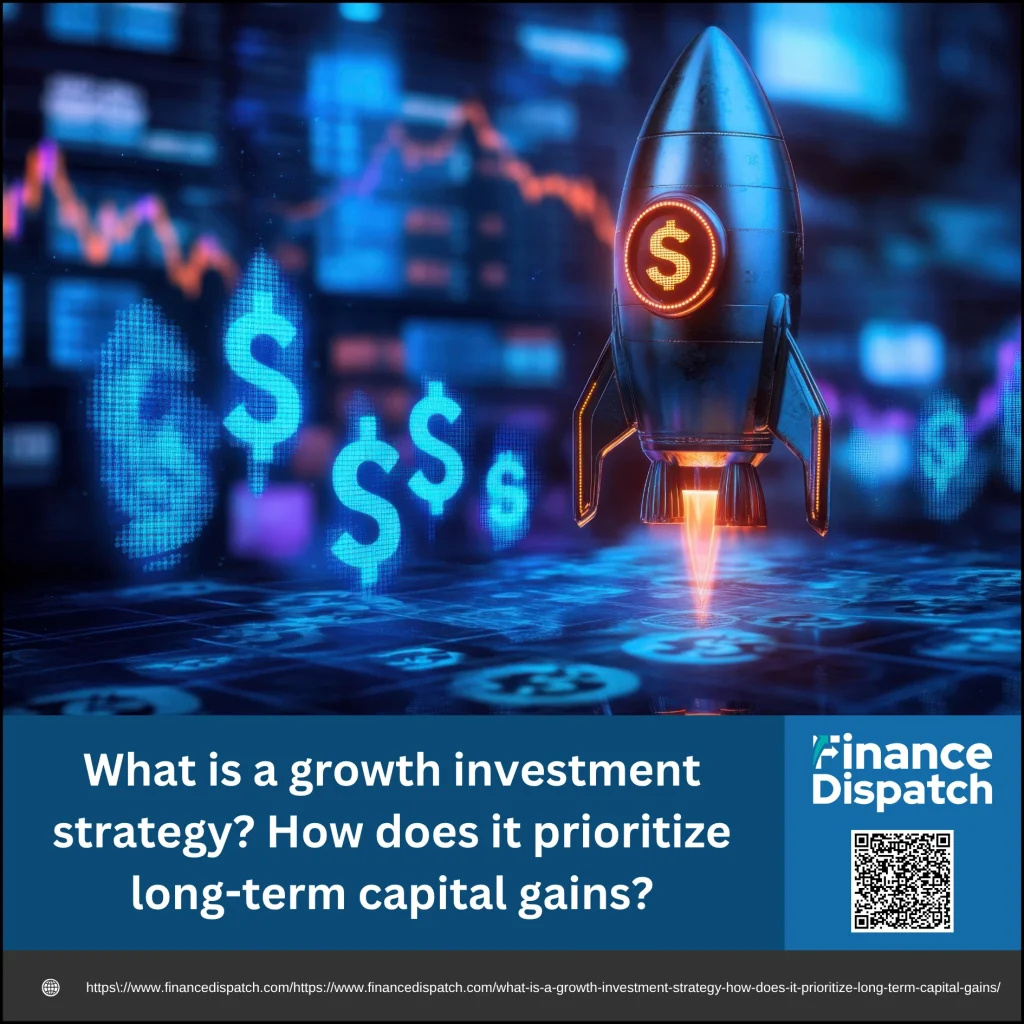When you think about building wealth through investing, one of the most talked-about approaches is growth investing. Unlike strategies that focus on undervalued stocks or immediate dividend income, a growth investment strategy emphasizes companies with the potential to expand faster than their peers or the overall market. These companies often reinvest their earnings into innovation, research, and expansion instead of paying out dividends, aiming to drive future profitability and market share. For investors, the appeal lies in the prospect of significant long-term capital appreciation—buying into today’s innovators with the expectation that their value will multiply over time.
What is Growth Investment Strategy?
A growth investment strategy is an approach that focuses on investing in companies expected to expand at a rate faster than the overall market or their industry peers. These are typically businesses in dynamic sectors such as technology, healthcare, or renewable energy, where innovation drives rapid development. Instead of distributing profits as dividends, growth-oriented companies usually reinvest their earnings into research, product development, or market expansion. For investors, the primary goal is capital appreciation—the potential to see the value of their shares increase substantially over time as the company scales and captures a larger market share.
 Key Characteristics of Growth Investments
Key Characteristics of Growth Investments
Growth investments are centered on companies that show the potential to deliver higher-than-average expansion. These companies often attract investors not because of what they earn today, but because of what they are expected to achieve tomorrow. Below are the defining features that set growth investments apart.
1. Focus on Future Potential
Growth investors seek out businesses with strong prospects for expansion, even if they are not yet profitable. These companies are often at the forefront of change—introducing disruptive technologies, new healthcare treatments, or innovative business models. The emphasis is on where the company is headed rather than where it currently stands, making forward-looking analysis a critical part of the strategy.
2. High Valuations
Growth stocks usually trade at higher price-to-earnings (P/E) ratios compared to the broader market. This happens because investors are willing to pay a premium for the promise of rapid earnings growth in the future. While these valuations reflect optimism, they can also increase risk, as even small disappointments in performance may trigger sharp stock price declines.
3. Reinvestment of Earnings
Instead of distributing dividends to shareholders, growth companies typically reinvest their profits back into the business. This reinvestment funds product development, technological innovation, new market entry, and scaling operations. By continually fueling internal growth, these companies aim to strengthen their market position and accelerate long-term capital gains for investors.
4. Capital Appreciation Goal
The primary motivation behind growth investing is long-term capital appreciation. Investors expect the stock’s value to rise significantly as the company expands and captures market share. Returns are not based on steady income from dividends but rather on the ability to sell shares later at much higher prices. This makes growth investing especially appealing to those who prioritize wealth accumulation over consistent cash flow.
5. Sector Emphasis
Growth strategies often gravitate toward industries undergoing rapid transformation. Technology, biotechnology, renewable energy, and consumer discretionary sectors are common examples where innovation creates opportunities for exponential growth. By targeting these high-potential areas, investors position themselves to benefit from industries that are shaping the future economy.
 How Growth Strategy Prioritizes Long-Term Capital Gains
How Growth Strategy Prioritizes Long-Term Capital Gains
The essence of a growth investment strategy lies in looking beyond short-term profits and focusing on the potential for future value creation. Unlike dividend-oriented approaches, growth strategies prioritize reinvestment, innovation, and market expansion, with the ultimate goal of generating substantial capital appreciation for investors over time.
1. Reinvestment of Profits
Growth companies often direct earnings back into research, product innovation, and expansion rather than distributing dividends. This reinvestment strengthens their long-term competitive position and drives stock price appreciation.
2. Focus on Innovation and Market Disruption
By targeting businesses that introduce transformative technologies or services, growth strategies align with industries that are likely to reshape the market. Successful innovations lead to sustained revenue growth and higher valuations in the future.
3. Patience for Compounding Returns
Investors in growth stocks adopt a long-term perspective, allowing compounding effects to take hold. Holding shares through multiple growth cycles often results in exponential wealth creation.
4. Valuation Based on Future Earnings
Growth investors accept paying higher price-to-earnings (P/E) ratios today, betting that future earnings growth will justify or exceed the current premium. This forward-looking approach is key to capturing capital gains down the road.
5. Sector Exposure to High-Growth Industries
Growth strategies emphasize sectors like technology, healthcare, and renewable energy—industries expected to drive long-term global expansion. Positioning within these sectors maximizes the chance of achieving above-market capital gains.
 Benefits and Risks of Growth Investment Strategy
Benefits and Risks of Growth Investment Strategy
A growth investment strategy offers the possibility of high rewards but also carries significant risks. By investing in companies with above-average growth prospects, investors look for substantial long-term gains. However, these same companies often operate in highly competitive, innovation-driven industries, which can make their stock values volatile. Below is a detailed look at both the benefits and risks.
Benefits of Growth Investment Strategy
1. High Return Potential
Growth companies that successfully expand revenues and capture larger market share can reward investors with exceptional stock price appreciation. For example, early investments in innovative firms such as Apple or Amazon generated returns many times higher than traditional investments, highlighting the wealth-building power of growth strategies.
2. Exposure to Innovation
Growth investing naturally aligns with industries where new ideas, products, and services emerge rapidly. Sectors like technology, biotechnology, and renewable energy offer opportunities for groundbreaking solutions. By investing in these businesses, investors participate directly in shaping future economic trends while benefiting from their upward trajectory.
3. Compounding Effect
When companies reinvest profits instead of paying dividends, they create opportunities for exponential growth. Each cycle of reinvestment fuels future earnings, and investors who hold onto these stocks benefit from the compounding effect—gains building on previous gains over many years.
4. Market Leadership Opportunities
Growth stocks often represent businesses that could become tomorrow’s industry leaders. By identifying companies early in their expansion phase, investors can take part in their journey from emerging player to dominant market force, capturing large capital gains along the way.
Risks of Growth Investment Strategy
1. High Volatility
Growth stocks tend to be sensitive to market expectations. If a company fails to deliver the projected growth, even a minor earnings miss can trigger a significant price drop. This volatility makes them riskier compared to value or dividend-paying stocks.
2. Lack of Dividends
Unlike value or income stocks, most growth companies do not pay dividends, as they channel profits back into operations. For investors seeking consistent income, this can be a disadvantage since returns depend entirely on selling shares at higher prices.
3. Overvaluation Risk
Because of their perceived future potential, growth stocks often trade at high price-to-earnings (P/E) ratios. This optimism can lead to overpaying. If the company’s actual performance fails to justify these valuations, investors may face steep losses.
4. Economic Sensitivity
Growth investments usually perform well during strong economic cycles but struggle during downturns. Rising interest rates or recessions can increase borrowing costs, slow expansion plans, and significantly reduce investor confidence, leading to underperformance relative to safer assets.
Who Should Consider Growth Investing?
Growth investing is best suited for individuals who are comfortable with higher levels of risk and have a long-term investment horizon. Since growth stocks often experience volatility and do not provide steady dividend income, they appeal more to investors focused on building wealth over time rather than seeking immediate cash flow. Younger investors, or those with years before retirement, may find this strategy especially attractive because it allows them to ride out market fluctuations while benefiting from the compounding effect of reinvested profits. On the other hand, growth investing may not be ideal for those seeking stable, short-term returns or relying on investments for regular income.
Practical Tips for Implementing Growth Strategy
Putting a growth investment strategy into practice requires careful planning, disciplined research, and patience. Since growth stocks often come with higher risks and volatility, investors need to balance ambition with caution. Following some practical guidelines can help maximize long-term gains while minimizing unnecessary risks.
1. Diversify Across Sectors – Avoid concentrating all your investments in one industry; spread them across multiple high-growth areas like technology, healthcare, and renewable energy.
2. Research Company Fundamentals – Look beyond stock price trends and analyze earnings growth, return on equity (ROE), and competitive advantages before investing.
3. Evaluate Management Quality – Strong, visionary leadership plays a vital role in turning growth potential into sustainable long-term performance.
4. Monitor Valuations – Be cautious about overpaying for growth stocks; use metrics like P/E or PEG ratios to assess if expectations are reasonable.
5. Adopt a Long-Term Mindset – Growth strategies work best when investors allow time for compounding and company expansion to unfold.
6. Balance Risk with Safer Assets – Mix growth investments with more stable holdings, such as bonds or dividend stocks, to cushion against volatility.
7. Regularly Review Portfolio – Keep track of performance and market trends, making adjustments when companies fail to meet growth expectations.
Conclusion
A growth investment strategy is built on the belief that tomorrow’s innovators and market leaders can generate substantial wealth for patient investors. By focusing on reinvestment, innovation, and long-term expansion, this approach prioritizes capital appreciation over immediate income. While it offers the potential for impressive returns, it also carries risks such as volatility and overvaluation, requiring investors to carefully manage their portfolios and maintain a long-term perspective. For those willing to embrace uncertainty in exchange for future rewards, growth investing remains a powerful pathway to building lasting financial gains.



